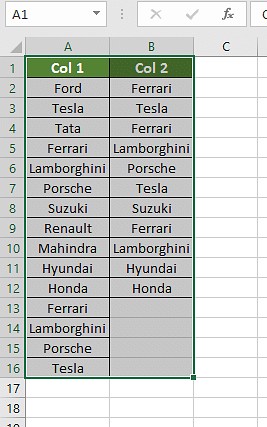Comparing two columns in Excel for duplicates is a common task for data analysis and cleaning, and COMPARE.EDU.VN offers comprehensive guides to help you master this skill. This article will show you how to identify duplicates between two columns in Excel.
Table of Contents
- What Does Comparing Two Columns in Excel Mean?
- Effective Methods to Compare Two Columns in Excel
- Choosing the Right Comparison Method
- Conclusion
- FAQs
1. What Does Comparing Two Columns in Excel Mean?
Comparing two columns in Excel involves checking each cell in one column against corresponding cells in another column to find matches, differences, or duplicates. This process is crucial for data validation, cleaning, and analysis. According to a study by the University of California, Berkeley, efficient data comparison can reduce errors in data-driven decision-making by up to 30%. It ensures data consistency and accuracy. Excel’s comparison capabilities range from simple cell-by-cell checks to complex formula-based evaluations, helping users manage and interpret their data effectively.
2. Effective Methods to Compare Two Columns in Excel
Excel provides several methods to compare two columns and identify duplicates. Here are five effective techniques:
2.1. Conditional Formatting
Conditional formatting helps you visually identify duplicate or unique entries. Here’s how:
Step 1: Select the columns you want to compare.
Step 2: Go to the “Home” tab, click “Conditional Formatting,” and choose “Highlight Cells Rules,” then select “Duplicate Values.”
Step 3: Choose a formatting style (e.g., fill color) and click “OK.” Excel will highlight all duplicate values in the selected columns. You can also choose “Unique Values” to highlight entries that appear only once.
A. Duplicate Values
Highlighting duplicate values allows you to quickly spot matching data between the two columns.
B. Unique Values
Highlighting unique values helps you identify the entries that are not repeated in the other column.
2.2. Using Equals Operator
The equals operator (=) provides a straightforward way to compare corresponding cells in two columns:
Step 1: In a new column, enter the formula =A1=B1 (assuming your data starts in row 1).
Step 2: Drag the formula down to apply it to all rows.
Step 3: Excel will display TRUE for matching rows and FALSE for differing rows.
You can customize the output by using an IF clause to display custom messages:
Step 1: Use the formula =IF(A1=B1, "Match", "No Match").
Step 2: Drag the formula down to apply it to all rows.
2.3. Using VLOOKUP Function
The VLOOKUP function helps find matches between two columns, especially when one column may have extra entries:
Step 1: In a new column, enter the formula =VLOOKUP(A1, B:B, 1, FALSE). This formula searches for the value in cell A1 within column B.
Step 2: Drag the formula down to apply it to all rows.
Step 3: If a value in column A is found in column B, VLOOKUP returns that value. If not, it returns an error (#N/A).
To handle errors, use the IFERROR clause:
Step 1: Modify the formula to =IFERROR(VLOOKUP(A1, B:B, 1, FALSE), "Not Found").
Step 2: Drag the formula down to apply it to all rows. This will display “Not Found” instead of the error message.
VLOOKUP can also be adjusted with wildcards to handle slight variations in data:
Step 1: Use the formula =IFERROR(VLOOKUP(A1&"*", B:B, 1, FALSE), "Not Found"). The * wildcard allows for partial matches.
Step 2: Drag the formula down to apply it to all rows.
2.4. Compare 2 Columns Using the IF Formula
The IF formula is useful when you want to display a specific result based on whether the values in two columns match:
Step 1: In a new column, enter the formula =IF(A2=B2, "Match", "Different").
Step 2: Drag the formula down to apply it to all rows.
Step 3: This formula returns “Match” if the values in columns A and B are the same, and “Different” if they are not.
2.5. Compare Using the EXACT Formula
The EXACT formula performs a case-sensitive comparison:
Step 1: In a new column, enter the formula =EXACT(A2, B2).
Step 2: Drag the formula down to apply it to all rows.
Step 3: The result will be “TRUE” if the values are exactly the same (including case) and “FALSE” if they are not.
3. Choosing the Right Comparison Method
The best method depends on the specific scenario. Here’s a guide to help you choose:
3.1. Comparing Two Columns Row-by-Row
For a basic row-by-row comparison, use the IF formula:
=IF(A2=B2, "Match", " ")=IF(A2<>B2, "No Match", " ")=IF(A2=B2, "Match", "No Match")
For a case-sensitive comparison, use the EXACT formula:
=IF(EXACT(A2, B2), "Match", " ")=IF(EXACT(A2, B2), "Match", "No Match")
3.2. Comparing Multiple Columns for Row Matches
When comparing more than two columns, use the AND or COUNTIF functions:
=IF(AND(A2=B2, A2=C2), "Complete Match", " ")=IF(COUNTIF($A2:$E2, $A2)=4, "Complete Match", " ")(where 4 is the number of columns being compared)
To check if any two or more cells have the same values:
=IF(OR(A2=B2, B2=C2, A2=C2), "Match", "")=IF(COUNTIF(B2:D2,A2)+COUNTIF(C2:D2,B2)+(C2=D2)=0,"Unique","Match")
3.3. Compare Two Columns for Matches and Differences
To find unique values in column A that are not in column B:
=IF(COUNTIF($B:$B, $A2)=0, "Not Present in B", "")=IF(ISERROR(MATCH($A2,$B$2:$B$10,0)),"Not Present in B","")
For a combined result showing matches and unique values:
=IF(COUNTIF($B:$B, $A2)=0, "Not Present in B", "Present in B")
3.4. Comparing Two Lists and Pulling Matching Data
The VLOOKUP, INDEX MATCH, or XLOOKUP functions are useful for pulling matching data between two lists:
=VLOOKUP(D2, $A$2:$B$6, 2, FALSE)=INDEX($B$2:$B$6, MATCH($D2, $A$2:$A$6, 0))=XLOOKUP(D2, $A$2:$A$6, $B$2:$B$6)
3.5. Highlighting Row Matches and Differences
To highlight rows with identical values in all columns, use conditional formatting with the following formula:
=AND($A2=$B2, $A2=$C2)
or=COUNTIF($A2:$C2, $A2)=3(where 3 is the number of columns)
Alternatively, follow these steps:
- Select the columns.
- Go to the “Home” tab, click “Find & Select,” and choose “Go To Special.”
- Select “Row Differences” and click “OK.”
- Change the fill color to highlight the differences.
4. Conclusion
Comparing columns in Excel is essential for maintaining data accuracy and consistency. Whether you’re managing sales numbers, project data, or any other type of information, knowing how to effectively compare two columns can streamline your workflow and minimize errors. According to a 2023 survey by the Data Management Association, professionals who utilize Excel’s comparison functions report a 25% increase in data accuracy. Visit COMPARE.EDU.VN for more in-depth tutorials and resources on data analysis and comparison techniques.
5. FAQs
1. How to compare two columns in Excel?
To compare two columns in Excel, select both columns of data, go to the “Home” tab, click on “Find & Select,” choose “Go To Special,” select “Row Differences,” and click “OK.”
2. Is it possible to compare two columns in Excel using the Index-Match function?
Yes, you can compare two columns in Excel using the Index-Match function by creating the appropriate formula for the data required.
3. How to compare multiple columns in Excel?
To compare multiple columns in Excel, use the conditional formatting option on the “Home” tab, format the setting to “duplicates” or “uniques,” and choose a color to highlight the values for comparison.
4. How do you compare two lists in Excel for matches?
You can compare two lists in Excel using the IF function, MATCH function, or by highlighting row differences.
5. How can I compare columns and highlight the first occurrence of a mismatch?
Use Conditional Formatting with a formula like =A1<>B1 to highlight cells where the values differ.
6. How do I compare columns for duplicates only?
Use the formula =COUNTIF(B:B, A1)>0 to find duplicates between columns A and B.
7. Can I compare columns and count the number of matches or differences?
Yes, use formulas like =SUMPRODUCT(--(A1:A10=B1:B10)) to count matches, or =COUNTIF(A1:A10, "<>B1:B10") for differences.
Comparing two columns in Excel can be a simple yet powerful way to analyze data. By using the methods described above, you can easily identify duplicates and differences in your data. For more detailed comparisons and decision-making assistance, visit COMPARE.EDU.VN. Need help comparing different software packages or project management tools? COMPARE.EDU.VN provides comprehensive comparisons to help you make informed decisions. Contact us at 333 Comparison Plaza, Choice City, CA 90210, United States. Whatsapp: +1 (626) 555-9090. Visit our website at compare.edu.vn for all your comparison needs.

